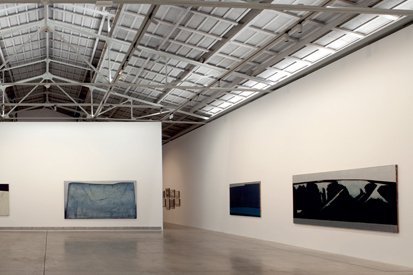Fundacio per amor al art de la CV

Anna-Eva Bergman: interpreter of light
TEXT: HANNAH JANE THOMPSON | PHOTO © JABALI STUDIO
For many who love travel, experiencing new places and new continents is about the hunt for new horizons, bright lights and undiscovered gems. Now, a new art display in Valencia on Spain’s eastern coast is showcasing an unusual and expansive mix of all three.
The Bombas Gens Centre d’Art on the Avenida de Burjassot, around 20 minutes’ walk from the city’s central market, opened in July 2017 and is home to more than 2,200 artworks from 200 artists – as well as a research and health area, and social day centre. The striking building’s strong lines and vaulted ceilings recall its past as a hydraulic pump factory (the name ‘Bombas Gens’ translates as ‘hydraulic pump’).
This might seem an odd place to host an exhibition focusing on light and travel, but a new show from 20th-century Norwegian artist Anna-Eva Bergman – called From North to South, Rhythms – does just that, occupying the bright space with ease.
The largely unknown collection comprises paintings created between 1962 and 1971, inspired by a series of trips Bergman made between her birth country of Norway and – fittingly – southern Spain.
It is clear: this work belongs here. This in itself is significant: one of the gallery’s main aims in hosting the event was to raise awareness of this underrated painter, whose art is largely unknown in Spain. Indeed, Bergman remains a mysterious figure for many, despite having since been described as ‘one of the most important abstract artists of the twentieth century’, and even being compared to the giant of abstract art – Mark Rothko.
This theme runs through many of the projects at Bombas Gens, with the parent foundation – the family-run Fundació Per Amor a l’Art – stating a clear intention to highlight artists who might not usually be seen elsewhere.
“The Per Amor a l’Art collection – which is exhibited at Bombas Gens – has a special interest in contributing to the dissemination and value of artists overlooked in the history of art,” explains general director Susana Lloret.
As Nuria Enguita, co-curator of Bergman’s show, admits: “She is very little-known here, and unfairly so.”
Yet, the Norwegian-born artist’s travels to Carboneras in Spain would significantly impact Bergman’s work for almost a decade.
Taking influences from the natural elements as she travelled, she consistently applied her distinctive style to landscape motifs between the two nations – including cliffs, fjords, mountains, stars, boats and the sea.
Her work also reflected the stark difference in light between the two countries, employing varied thicknesses of paint – and even using materials such as metal foil, gold leaf, and copper – to play with the ever-changing nature of the horizon.
It is this melding of inspiration that comes most alive in the Bombas Gens exhibition.Indeed, the show itself represents cooperation between nations, and Bergman’s international past: the event is partnered by the Fondation Hartung Bergman in France (as, despite her love of Spain, Bergman spent much of her life in Paris and Antibes).
Fondation president, Daniel Malingre, has said that this collaboration’s primary aim is to “disseminate and expand knowledge of Anna-Evan Bergman’s work”.
The gallery’s stark, clean halls (so different to the building’s rustic, historic exterior) help to further emphasise the expansive, geometric nature of Bergman’s work, and the 65 pieces are hung sparsely, appearing in crisp contrast to the bold colours, shapes, and brush strokes they display.
Bergman was not content for her work to be described as simply ‘abstract’. As Christine Lamothe, Bergman expert and co-curator of the show, explains: “Anna-Eva Bergman started in figurative painting, but from the 1950s onwards, she invented a completely personal abstraction, which, rather than ‘Abstract Art’, she preferred to call ‘the art of abstraction’.” The exhibition continues until 5 May 2019, and offers a unique perspective on Spain – a country as southern European as Norway is northern – and decoding cross-country visual influences as an interpreter does with sound.
“[Bergman] captured the essence of nature, and translated it into artworks that contain a symbolic language of personal and yet simple forms,” continues Lamothe.
“This is not a traditional retrospective,” adds Enguita. “It focuses on a specific period…which posed a permanent dialogue between north and south, and a very different representation of colour and light.”
Subscribe to Our Newsletter
Receive our monthly newsletter by email





